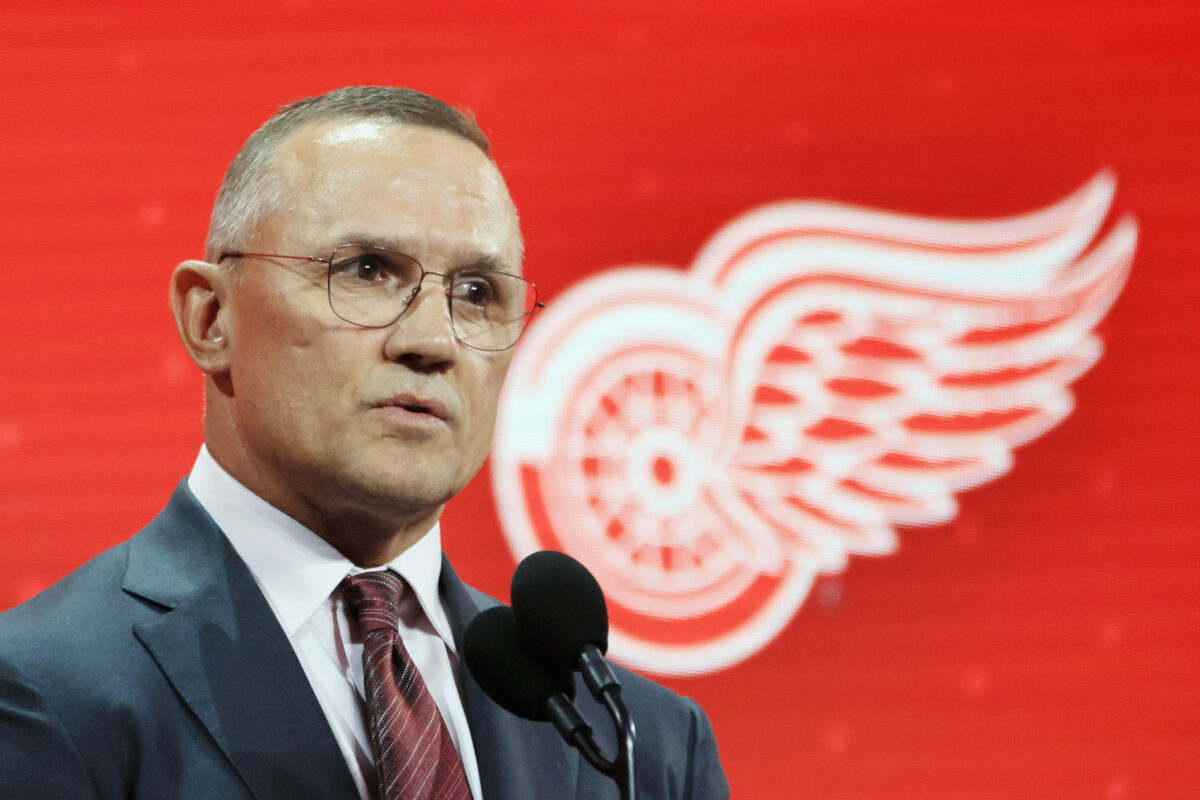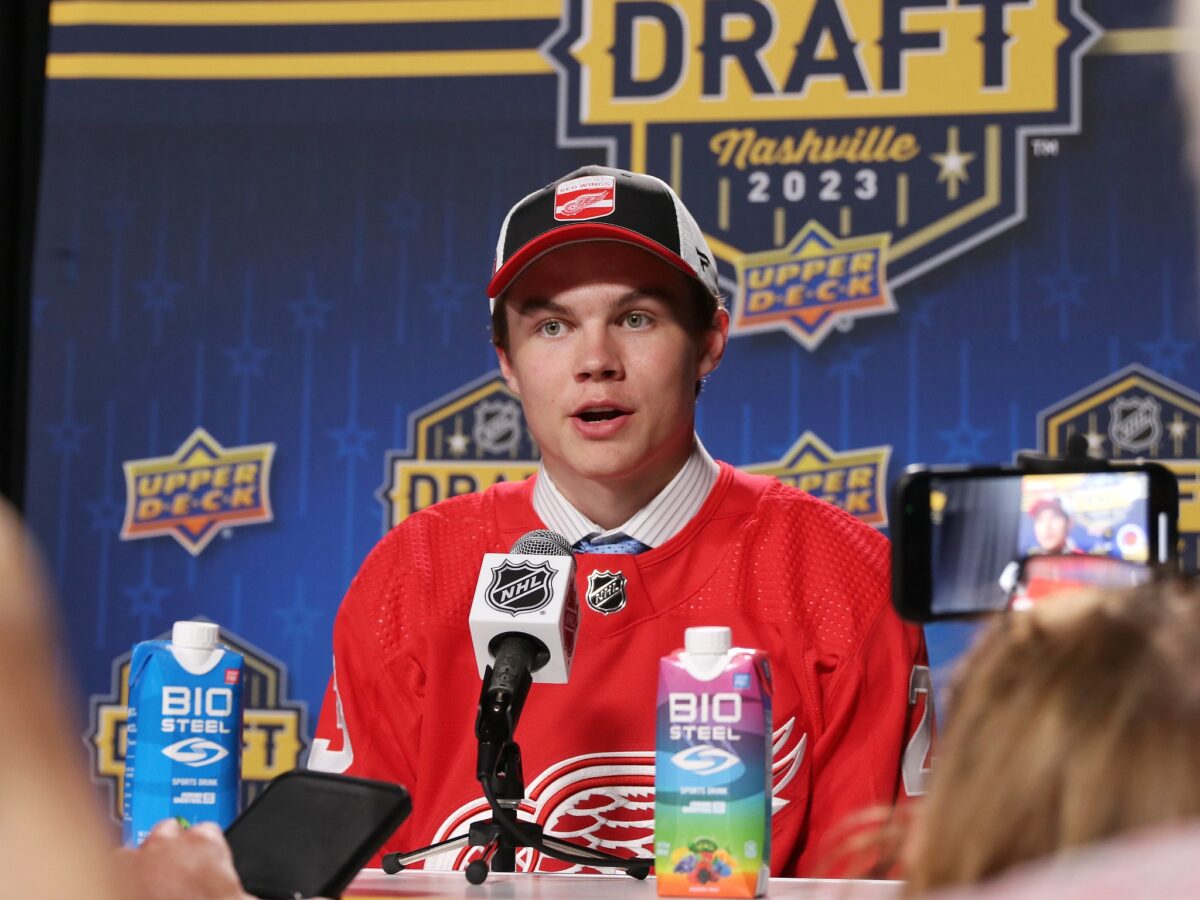Plenty of ink has been spilled since the NHL’s Free Agency arrived on July 1 about the uncharacteristically quiet offseason for Steve Yzerman and the Detroit Red Wings. Through the first few days of free agency, the team hadn’t added any significant assets, and had lost an important leader and depth scorer in David Perron, not to mention the brutal Jake Walman trade that baffled hockey fans the world over.
This was a Red Wings team that missed out on the playoffs by a tiebreaker of all things, a team that theoretically should have been aggressive this summer in raising their long term ceiling so they could become consistent contenders rather than a coin flip to make the playoffs, and instead it looked like they decided to bring back mostly the same group next year.
Fans were getting riled up, and rightfully so as the team dealt a fan favorite in Walman for less than nothing and then proceeded to do nothing with the cap space that move offered them. The signing of Vladimir Tarasenko helped to soften the blow a bit, adding another competent top-six winger to a team in desperate need of offense, but Tarasenko’s days as a star player in this league have passed so that didn’t smooth feathers all that much.
Related: 3 Keys to Red Wings’ Offseason Strategy

Despite all the doom and gloom, I’m going to make the case that the team actually did as good as you could ask from a franchise that is a few more bloated contracts away from being trapped in the mushy middle. Not only did Detroit refrain from making any more unforced errors in free agency (eg. Ben Chiarot, Justin Holl), but they appear to be preparing to usher several of their young players into the NHL lineup which is their most realistic path to upgrading their ceiling long-term.
Free Agency Wins
It technically happened just before free agency opened, but the Red Wings extending Patrick Kane at $4M for next season is obviously a tidy piece of business, considering the offensive impact he made last year despite coming off of hip resurfacing surgery. Kane scored 47 points in 50 games with Detroit in the 2023-24 season, a 77 point pace over a full season. Even if Kane can score roughly 25 goals and 60 points, he would be an excellent value add in the top-six.
Behind Tarasenko’s deal, the largest contract that Detroit signed, in terms of total salary, was with Cam Talbot who they signed to a two-year deal worth $2.5M/year. With Ville Husso and Alex Lyon’s contracts finishing after this upcoming season, I think it’s fair to assume the team hopes Talbot can hold down the crease until Sebastian Cossa takes over in a couple of seasons. Talbot isn’t just another warm body to line up between the pipes, he’s a legitimate starting goaltender in the NHL still, with a career .913 save percentage (SV%) that greatly outperforms the numbers of Husso (.902 SV%) and Lyon (.903 SV%).
They also signed Erik Gustaffson to a two-year deal worth a total of $4M, as well as a handful of one-year deals to depth pieces like William Lagesson, Tyler Motte, and Christian Fischer. Does the team have too many goalies? Yeah probably, but I believe that adding Talbot does legitimately improve their goaltending situation for next season (though just marginally) and they didn’t commit all that much cap space in the near or far future.
What Were the Other Options?
Plenty of people have complained about the deals Detroit has handed out in free agency over the past few summers, with a significant portion of the team’s cap space going to players who have raised the team’s floor without meaningfully raising their ceiling. While it would have been nice if they had landed a star-level player in free agency this year, no players of that talent level even made it to July 1.
The two best forwards available, Jake Guentzel and Sam Reinhart, both signed contracts the day before free agency opened, and the best players left on the board either wouldn’t have been worth the cost or wouldn’t have lined up with the team’s realistic timeline. Steven Stamkos hit free agency and landed a four year deal with the Nashville Predators with an annual cap hit of $8M, which would clearly have priced Detroit out.
There weren’t many other contracts signed in this year’s free agency period that you look at and go “Detroit should have offered that deal”, with Viktor Arvidsson’s 2x$4M contract being the only standout. However, there are rumours he was offered more money on the open market but took a pay cut to play on the wing with Connor McDavid and Leon Draisaitl.
Are there really any other contracts signed that you’re upset Detroit wasn’t in on? Jonathan Marchessault was overpaid and so was Chandler Stephenson. Jake DeBrusk’s contract in Vancouver is intriguing, especially with the potential for an offensive boom if he earns consistent power play time, though I’m confident Red Wings fans would be up in arms about signing that seven year deal.
While it’s clear that the team was incredibly quiet during this year’s free agency period, they didn’t really have a better option anyway, unless they wanted to dig themselves a deeper hole. Obviously you can’t give them that much credit for not worsening a problem that they caused, but it was encouraging to see Detroit’s management group seemingly recognize their recent mistakes and take a more careful approach when it came to total cap dollars spent.
Why This Was the Best Option Long Term
If you look at Detroit’s projected opening night lineup and their prospect pool, it quickly becomes clear that the team is best set up for success once guys like Axel Sandin-Pellikka (ASP), Marco Kasper, and Nate Danielson are serious contributors in the NHL (assuming they reach that level), so the development of those players should be incredibly high on the team’s list of priorities.

While the team may not have opened up anything like a guaranteed roster spot to guys like Danielson, Kasper, or Carter Mazur, they do have some wiggle room toward the bottom of the roster, as well as soon-to-be-expiring contracts with Kane and Tarasenko in back-to-back summers. This gives the team the freedom to graduate one or more of the youngsters into the NHL this season if they really impress at training camp, but also gives them a clear spot in the near future if they don’t all blow the doors off this Fall.
Also, since the team didn’t make any significant cap commitments this time around, they are lined up to clear over $10M in cap space at the end of next season with expiring contracts to Husso, Olli Määttä, Jeff Petry, and the buyout penalty for Kailer Yamamoto.
Finally, a Net Neutral Free Agency
It’s not exactly the best sign that simply holding back from making a couple of obvious mistakes is an improvement, but managing to maintain the general talent level of the lineup while introducing Simon Edvinsson as a full time NHLer and some continued development from could see Detroit improve in the standings by a small handful of points. The playoff bar was unusually low last season, so I’m not convinced that the Red Wings will be in the race until the final night of the regular season like they were last year, but I do think they’ll be a wild-card/bubble team once again this year, with meaningful games taking place late in the season.
Did Detroit raise their ceiling as a team in the league’s toughest division that is only going to get tougher next season? No, I don’t think they did. Despite that fact, I think they had a successful free agency (and offseason, by extension) by refraining from making any more short-sighted signings that would limit them going forward and by building available roster spots into their cap sheet to allow space for their top prospects to work their way into the NHL on a reasonable timeline.
